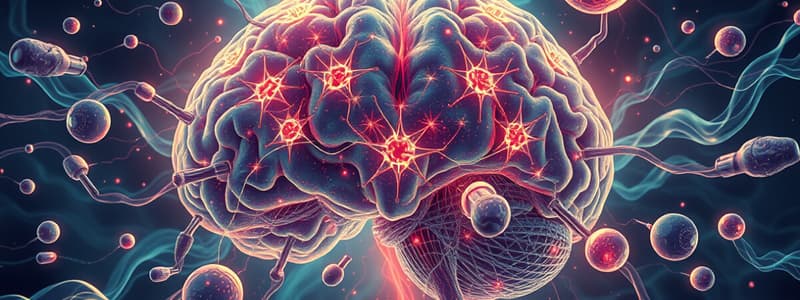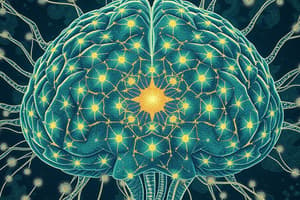Podcast
Questions and Answers
What is the primary clinical application of Pirenzepine?
What is the primary clinical application of Pirenzepine?
- Prevention of motion sickness
- Treatment of asthma
- Reduction of gastric secretion in peptic ulcer patients (correct)
- Induction of mydriasis for eye examinations
Which drug is specifically contraindicated for patients suffering from glaucoma due to its potential to increase intraocular pressure?
Which drug is specifically contraindicated for patients suffering from glaucoma due to its potential to increase intraocular pressure?
- Oxybutynin
- Ipratropium
- Tropicamide (correct)
- Benztropine
What is a common adverse effect associated with the use of antimuscarinic agents?
What is a common adverse effect associated with the use of antimuscarinic agents?
- Bradycardia
- Constipation (correct)
- Excessive salivation
- Increased secretions
In which situation can antimuscarinic agents act as specific antagonists?
In which situation can antimuscarinic agents act as specific antagonists?
How does Ipratropium primarily exert its therapeutic effects?
How does Ipratropium primarily exert its therapeutic effects?
What central nervous system effects can Hyoscine have at therapeutic doses?
What central nervous system effects can Hyoscine have at therapeutic doses?
What is the primary therapeutic application of Methacholine?
What is the primary therapeutic application of Methacholine?
Which of the following is NOT a side effect associated with cholinomimetics?
Which of the following is NOT a side effect associated with cholinomimetics?
What effect does low-dose nicotine have on the ganglia?
What effect does low-dose nicotine have on the ganglia?
Bethanechol is predominantly effective on which type of receptors?
Bethanechol is predominantly effective on which type of receptors?
Which of the following is true about ganglioplegic agents?
Which of the following is true about ganglioplegic agents?
What is the duration of action for Bethanechol when used subcutaneously?
What is the duration of action for Bethanechol when used subcutaneously?
What is a major limitation of choline esters as therapeutic agents?
What is a major limitation of choline esters as therapeutic agents?
Which cholinomimetic is commonly used in the treatment of glaucoma through eye drops?
Which cholinomimetic is commonly used in the treatment of glaucoma through eye drops?
Which of the following effects is associated with high-dose nicotine?
Which of the following effects is associated with high-dose nicotine?
What contraindication is associated with the use of cholinomimetics?
What contraindication is associated with the use of cholinomimetics?
What type of receptor selectivity do direct parasympathomimetic drugs possess?
What type of receptor selectivity do direct parasympathomimetic drugs possess?
Which of the following drugs is classified as a cholinergic antagonist?
Which of the following drugs is classified as a cholinergic antagonist?
Which adverse effect is commonly associated with ganglion blocking agents?
Which adverse effect is commonly associated with ganglion blocking agents?
What is a common effect of activating M2 receptors on the heart?
What is a common effect of activating M2 receptors on the heart?
Which drug is known for both muscarinic and nicotinic actions?
Which drug is known for both muscarinic and nicotinic actions?
Which symptom is associated with nicotinic stimulation during cholinergic syndrome?
Which symptom is associated with nicotinic stimulation during cholinergic syndrome?
What is a common therapeutic application of nicotine?
What is a common therapeutic application of nicotine?
What decreases as a result of cholinergic stimulation on smooth muscle?
What decreases as a result of cholinergic stimulation on smooth muscle?
What characterizes the effects of DMPP as a ganglion blocker?
What characterizes the effects of DMPP as a ganglion blocker?
Flashcards are hidden until you start studying
Study Notes
Ganglia-Acting Drugs Overview
- Diverse actions with no therapeutic applications.
- Includes stimulants and ganglion blockers.
Stimulants
- Stimulate both sympathetic and parasympathetic systems.
- Effects include:
- Tachycardia
- Increased blood pressure
- Altered gastrointestinal motility and secretions
- Enhanced bronchial, salivary, and sweat secretions
- Nicotine has a significant CNS stimulant effect.
Nicotine
- Low doses: Stimulates ganglia, increasing blood pressure, heart rate, peristalsis, and secretions.
- High doses: Blocks ganglia, leading to decreased blood pressure, reduced gastrointestinal motility, bladder muscle effects, and respiratory paralysis.
- Transdermal use for smoking cessation.
Ganglion Blockers
- Act on both autonomic and enteric ganglia, predominantly affecting the sympathetic system.
- Formerly used as antihypertensives but replaced by more selective drugs.
- Significant side effects include reduced sympathetic and parasympathetic tone, dry mouth, and urinary retention.
Examples of Ganglion Blockers
- Hexamethonium
- Mecamylamine
Direct Parasympathomimetic Drugs
- Comprised of choline esters and alkaloids.
- Generally non-selective for muscarinic receptors; leads to numerous side effects.
Choline Esters
- Acetylcholine: Acts on both muscarinic and nicotinic receptors; low therapeutic value due to rapid degradation.
- Carbachol: Potent, acts on cardiovascular and GI systems; used rarely as eye drops for glaucoma.
- Methacholine: More selective for M3 receptors used in bronchial challenges; minimal side effects.
- Bethanechol: Selective for muscarinic receptors; used for urinary retention and GI motility issues.
Effects of Choline Esters
- Bradycardia and vasodilation reducing blood pressure.
- Smooth muscle contractions in urinary and GI tracts.
- Miosis and increased exocrine secretions.
Therapeutic Applications of Choline Esters
- Cardiology: Acetylcholine and Methacholine for atrial tachycardia.
- Gastroenterology: Bethanechol and Carbachol for gastric atony and urinary retention.
- Ophthalmology: Acetylcholine and Carbachol in cataract surgery.
Alkaloids
- Muscarine: Natural compound affecting muscarinic receptors.
- Pilocarpine: Commonly used for glaucoma and xerostomia; stimulates secretions.
- Arecoline: Acts on both nicotinic and muscarinic receptors.
- Oxotremorine: Synthetic; causes parasympathetic overactivity; treated with atropine.
Cholinergic Syndrome Symptoms
- Muscarinic: Miosis, excessive secretion, abdominal pain, bradycardia.
- Nicotinic: Fasciculations, respiratory depression, tachycardia, hypertension.
Contraindications for Cholinomimetics
- Asthma, bowel obstruction, peptic ulcer, coronary insufficiency.
Cholinergic Antagonists
- Include both antimuscarinic and antinicotinic drugs, exhibiting limited specificity.
Antimuscarinic Drugs
- Atropine: Leads to mydriasis, bronchodilation, and reduced secretions; CNS effects range from mild excitement to severe toxicity.
- Hyoscine (Scopolamine): Causes sedation and prevents motion sickness; crosses the blood-brain barrier easily.
- Ipratropium: Primarily bronchodilative; helpful in asthma treatment.
- Benztropine: Useful in Parkinson’s treatment.
- Tropicamide and Cyclopentolate: Induce mydriasis and are used in intraocular pressure issues.
Effects and Applications of Antimuscarinic Drugs
- Useful in motion sickness, ocular conditions, respiratory treatments, GI motility reductions, and genitourinary issues.
- Common side effects: dry mouth, constipation, blurred vision, particularly problematic in glaucoma patients.
Nicotinic Drugs Summary
- Include ganglion blockers and neuromuscular blockers, influencing various functions and syndromes, notably in Parkinson’s treatment.
Studying That Suits You
Use AI to generate personalized quizzes and flashcards to suit your learning preferences.




